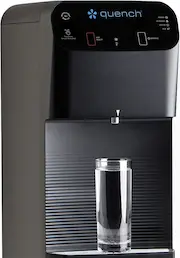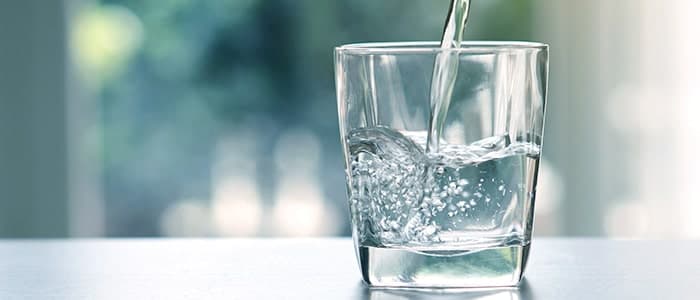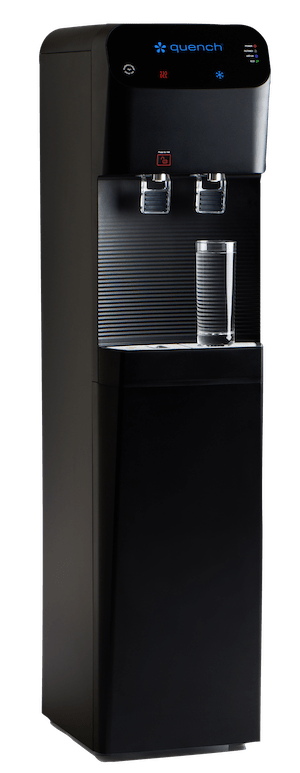Gone are the days when drinking water was as simple as turning on the faucet. Now, there are so many different types of water bottles, water coolers, water dispensers, and water delivery services… along with a host of filtration and sanitization technologies – which is a good thing! Although it may sound complicated, your Quench water experts are here to explain.
Quench Water Glossary Terms:
A: Activated Carbon Filtration, ADA Compliance, Adsorption, Antimicrobial Protection
B: BioCote® Anti-microbial Protection, Biofilm, Bottled Water, Bottleless Water, BPA
D: Distilled Water/Distillation
E: Energy Star, ETL Certification
G:
J:
K:
L: Lead Reduction Filtration Solutions
M: Mains Water or Water Main Water (Tap Water)
N: National Sanitation Foundation (NSF)
P: Plumbed-in Water Cooler, Point-of-Use (POU) Water Cooler, Preventative Maintenance
Q:
R: Reverse Osmosis (RO) Water Filtration
S: Sediment Filter, Silver Ion Antimicrobial Action
T: Tap Water, Total Dissolved Solids (TDS)
U: UL Listed, Ultraviolet (UV) Sanitization
V:
W: Water Cooler, Water Cooler Contract, Water Cooler Costs, Water Cooler Features, Water Cooler Sanitation, Water Cooler Storage Tanks, Water Delivery, Water Dispenser, Water Filtration System
X:
Y:
Z:
Quench Water Glossary Definitions:
Activated Carbon Filtration – Activated carbon is widely used in filtration systems, from air filters to blood filters. It’s essentially a form of charcoal with a very high surface area. This adsorbs a wide range of molecules that it encounters. Activated carbon filtration systems for water can trap and remove a large percentage of impurities in water. Activated carbon filtration is common in bottleless water systems; however, an even higher percentage or impurities can be removed using reverse osmosis. Learn more by downloading our Advanced Carbon Filtration Information Sheet.
ADA Compliance – The American with Disabilities Act of 1990 (ADA) is a wide-ranging civil rights law that ensures individuals with disabilities can fully access and use public places and services. As such, the ADA contains standards for public places, buildings, and services, including drinking water fountains and water coolers. Download our ADA Compliance Information Sheet to learn how a water cooler is ADA compliant.
Adsorption – The process of capturing molecules through the adhesion of atoms, ions, biomolecules or molecules of gas, liquid, or dissolved solids to a surface (not to be confused with absorption). This is the mechanism by which activated carbon filtration works. Once the surfaces of a grain of activated carbon are completed coated with adsorbed particles, the filter is exhausted and performance drops. Therefore, the higher the filter surface area, the more effective the filter performance in removing contaminants and the longer the filter lasts.
Antimicrobial Protection – Silver ion technology which can be impregnated into the water cooler. This can be used on all the surfaces that touch the water in the water cooler, including the faucets, push buttons, catch trays, catch tray surrounds, and the tops of coolers.
BioCote® Anti-microbial Protection – This silver ion-based technology is incorporated into the surfaces of certain bottleless water coolers at the time of manufacture and provides continuous built-in antimicrobial protection for the expected lifetime of the water cooler. This anti-microbial protection inhibits the growth of molds, yeasts and a broad spectrum of micro-organisms, including E. coli.
Biofilm – A slimy combination of bacteria, fungi, algae, and protozoa, which adhere to each other and to a surface. This develops in unchlorinated water that is not subject to sanitization. You may have seen this effect in fish tanks that haven’t recently been cleaned. It is commonly found in bottled water coolers which have not been sanitized.
Bottled Water – Old-fashioned water coolers are supplied using plastic bottles full of water, which are costly; need constant replacement of 42 lb. (5 gallon) water jugs; are at risk of contamination from bacteria and BPA; can cause workplace accidents and workers compensation claims when bottles are replaced; are made of plastic and therefore increase our dependence on foreign oil; and are environmentally unfriendly.
Bottleless Water – Water delivered from a water cooler which does not have a bottle. Once a bottleless water cooler has been installed, it’s ready to use and there are no bottles to replace. Costs are lower. There are various filtration types, and filtration is done within the machine itself. With closed systems and sanitation features, and no BPA from plastic bottles, the water is clean and safe. As there are no bottles to replace, there’s no oil used to make plastic bottles or to ship the full and empty bottles, so bottleless water is a much more environmentally-friendly solution.
BPA – BPA (bisphenol-A) is a chemical used as a hardening agent in plastic bottles. BPA leaches out of plastic and into water. Several regulatory agencies now view BPA as a possible carcinogen, and a few states and the country of Canada now ban the use of BPA in food- or drink-related containers. However, many bottled water systems still contain BPA in the bottles. Bottleless water is a healthy alternative that does not contain BPA.
Closed System Water Cooler – Closed systems such as bottleless water do not provide an opportunity for dirt and germs to enter the system. The water supply is contained within the system, and with ultraviolet sanitization and anti-microbial protection the water is completely safe. Compare open system water coolers.
Distilled Water/Distillation Distilled water is water that has many of its impurities removed through the process of distillation. Distillation involves boiling the water and then condensing the steam into a clean container; impurities dissolved or suspended in water cannot transform to vapor phase with water, so they are left behind in the “brine”. Water that has been distilled is ultra-pure, and may taste flat compared with other water, so it is generally not used for drinking purposes. Distilled water is frequently used for medical, dental, or industrial processes. Some bottleless water coolers offer distilled water, which may be convenient and cost-effective for low-volume applications.
Energy Star – Established in 1992 as part of the Clean Air Act, Energy Star is a program run by the U.S. Environmental Protection Agency (EPA) that helps businesses and individuals save money through energy efficiency. Water coolers are tested by measuring the energy being used in a 24-hour period to maintain cold and/or hot water at the appropriate dispensing temperature. Quench currently has 3 Energy Star certified water coolers, the 640, the 720, and the 760. While not all Quench water coolers are Energy Star certified, they are more energy efficient than the delivery of 5-gallon plastic jugs. If you would like to learn more about Energy Star, please read our Energy Star Information Sheet.
ETL Certification – The ETL Listed Mark is proof of product compliance (electrical, gas and other safety standards) to North American safety standards. The ETL Mark is assurance that the water cooler is compliant with safety standards, having been tested and certified by a third-party organization. It is comparable to the better-known Underwriters Laboratory (UL) mark.
Filter Changes – Activated carbon filters must be changed regularly to ensure that they provide top quality water filtration. Bottleless water companies change filters as part of their service, either with or without an additional charge.
Home-Office Delivery (HOD) – Another term for Bottled Water, which is delivered periodically to replenish consumed stocks.
Impurities in Water – Impurities found in water supplies may include large particles, such as dirt, cysts, and asbestos fibers; hard water impurities, such as calcium, magnesium, manganese, and iron; heavy metals, such as lead; micro-organisms such as bacteria, fungi, algae, and protozoa; dissolved solids, such as salts and nitrates; organic molecules that give off-tastes and odors; chlorine; and fine particles. Water impurities can be removed using water filtration systems such as bottleless water filtration systems.
Lead Reduction Filtration Solutions – For more information please visit the NSF website by clicking here. Download our Advanced Carbon Filtration Data Sheet for detailed performance information. Download our Reverse Osmosis Filtration Data Sheet for detailed performance information.
Mains Water or Water Main Water (Tap Water): Water from a municipal water distribution system – water coming from a “water main”, or the distribution piping buried through cities and towns. Mains water is the supply for bottleless water coolers – and the source for most bottled water bottling plants, as well.
National Sanitation Foundation (NSF) – NSF International is a not-for-profit, non-governmental organization that provides standards development, product certification, auditing, education and risk management for public health and safety. The NSF is a third-party certification body, which certifies that drinking water products are safe. All water filtration systems should be NSF certified. Quench water coolers and ice machines use the Everpure NSF Certified system QL2-OCS2 with replacement cartridge OCS2 or the Omnipure NSF Certified system K2333JJ.
Open System Water Cooler – Open systems such as bottled water dispensers have a human factor – someone must replace the bottles. They may introduce dirt and germs into the system, by touching the top of the bottle or the connection point, sneezing on it, or allowing dust and germs in the air to encounter the water supply. Dirt and other impurities and germs, bacteria, fungi, and biofilm may end up in contact with the water. Compare closed system water coolers, such as bottleless water, which have internal water supplies and always give clean and healthy water.
Plumbed-in Water Cooler – Water coolers supplied by potable water public water systems such as tap water, running water, city water, and municipal water. The water is filtered and sanitized at the water cooler, providing clean, healthy water.
Point-of-Use (POU) Water Cooler – Point of use water treatment provides water that’s treated at the place where it’s used. The water is filtered and sanitized, so the water cooler produces fresh, pristine water. For more context, visit Point of Use vs. 5 Gallon Water Coolers.
Preventative Maintenance – What is included in a Quench preventive maintenance service call? As part of Quench’s comprehensive service program, a highly-trained, certified Quench technician will routinely conduct a 11-point inspection and maintenance service on your Quench machine to ensure your office drinking water, ice, and/or coffee is always clean and great-tasting. To learn more, download our Preventive Maintenance Information Sheet.
Reverse Osmosis (RO) Water Filtration – Reverse Osmosis (RO) is a water purification technology that removes dissolved solids from drinking water. Dissolved solids are small organic and inorganic particles that are suspended in water. Dissolved solids vary by location, but include chemicals like salts, calcium, and phosphates. Water with high total dissolved solids (TDS) levels often appear cloudy and can have “off” odors. Quench recommends reverse osmosis filtration for customers who rely on well water or have tap water with TDS levels of 400 ppm or higher. RO technology is standard on the Quench Q12 and optional on all other coolers. All RO-equipped water coolers require a drain line.
Sediment Filter – A mechanical filter (meaning physical filter fibers obstruct contaminants, as opposed to adsorption filters, which use chemical processes) which traps large particles suspended in water. Water with high sediment levels, typical in very old municipal water systems such as those in New York City, may rapidly clog fine filters and shorten their life, reduce water flow, and generate bad tastes in the water. Sediment filters trap those larger particles before the water reaches other filter elements, improving filter performance and extending life.
Silver Ion Antimicrobial Action – Silver has been used for centuries as an antimicrobial agent, but new technology has made it practical for wide use as a surface antimicrobial. Silver embedded in the surfaces of various elements of a water cooler acts as a powerful inhibitor of microbial growth, keeping surfaces clean and biofilm-free.
Tap Water – Water supplied to a tap (valve) that is used for drinking, washing, cooking, cleaning, and bathing. Indoor tap water is distributed from municipal water treatment plants through indoor plumbing.
Total Dissolved Solids (TDS) – This term refers to the collection of substances contained within water, notably drinking water. TDS can be molecular or micro-granular in size, and is typically comprised of minerals like calcium, magnesium, and manganese. High TDS counts can create taste issues. The United States has established water quality standards to account for safe levels of total dissolved solids, though these standards are not always adhered to. On top of these standards, Quench recommends reverse osmosis (RO) water filtration for water with TDS over 350 ppm (parts per million). RO typically reduces TDS to under 25 ppm; distillation reduces TDS to under 10 ppm. Bottled mineral water typically has a TDS level 400-650 ppm. Learn more by downloading our TDS Information Sheet.
UL Listed – Underwriter’s Laboratory (UL) is an independent, global organization that tests and certifies electrical devices and appliances, such as bottleless water coolers, for safety. Being UL Listed is an important certification or comparable proof of third-party testing, such as ETL, is a standard criterion for a very broad range of products, including water coolers. UL Listed implies a level of safety, imparting confidence to the customer.
Ultraviolet (UV) Sanitization – UV sanitization is used to guard against bacteria and other micro-organisms. When unchlorinated water is stored for any period, it is a prime breeding ground for heterotrophic (non-disease-causing) bacteria and micro-organisms. That can lead to a build-up of biofilm. Ultraviolet sanitization can be used in bottleless water system tanks to inactivate or kill micro-organisms, typically by destroying their DNA or their cell wall membranes. Independent testing has certified UV technology to eliminate 99.9999% of bacteria, 99.999% of viruses, and 99.9% of parasites. Learn more how UV Sanitization ensures Quench filtered water stays clean and fresh by downloading our UV Sanitization Information Sheet.
Water Cooler – Water coolers come in two main types – bottled water and bottleless water. Some bottled water coolers use spring water, but many are simply filled with municipal water which has been filtered. Bottleless water coolers filter the water at the time and place that it will be used, so it is pure and healthy.
Water Cooler Contract – Water coolers are paid for in a variety of ways. Some of the watercooler units are purchased outright and then bottles of water are paid for separately. Other times, the with water cooler rental, the unit is rented and there is a plan for the number of bottles to be supplied each month. Bottleless water coolers are generally rented, and some companies ask for long-term contracts which may last several years. Most companies prefer bottleless water companies to offer month-to-month contracts.
Water Cooler Costs – Water cooler costs come from two main sources – the water cooler unit, and service elements such as bottle replacement or filter replacement. Bottled water is expensive in a number of ways: cost of water cooler unit – initial cost, rental, maintenance; cost of replacement bottles – which include the bottle itself, the filtration, the transportation (drivers and trucks), and the removal and disposal of used bottles; cost of workplace accidents and workers compensation claims for replacing heavy 5-gallon jugs, which weight 45 lb. each; and cost of square footage required to store bottles. Bottleless water, on the other hand, tends to be lower cost because there are no bottles to replace. Cost savings for bottleless water coolers are generally 30-50% compared with bottled water.
Water Cooler Features – Water coolers may feature: cold water – for drinking straight or adding flavors; hot water – for coffee, tea, hot water, and other hot drinks; room temperature water (also known as tepid water, or ambient water) – for drinking straight or adding flavors; extra hot water – for tea and other drinks that require very high temperature water; sparkling water – for drinking straight or adding flavors; nugget ice – ice dispensers provide an easy source of ice for drinks and other uses.
Water Cooler Sanitation – According to the International Bottled Water Association (IBWA), Bottled water coolers should be sanitized every 3 months by bleaching and/or scrubbing, to avoid the development of biofilm and other health hazards. On the other hand, bottleless water coolers may have an in-built sanitation system consisting of ultraviolet sanitization and antimicrobial protection.
Water Cooler Storage Tanks – The storage tanks in bottleless water coolers provide a receptacle for cooling and heating water. Bottleless water dispensers that are designed for large numbers of people have larger tanks, so the hot and cold water don’t run out.
Water Delivery – Water is delivered to organizations in several ways. Some organizations use tap water/municipal water – when used straight from the faucet, this is cheap but contains chlorine and may contain lead and other impurities. Filtering it with a replaceable water filter gets rid of some of the impurities in water, but not all of them, and it can be expensive and difficult to manage. Some companies use individual water bottles, which are environmentally unsustainable and usually contain BPA. Others use bottled water delivery using coolers, which are also environmentally unfriendly and can be unhealthy as well as costly. A more modern approach, which is also considered much greener, is bottleless water. For more information, visit Better Drinking Water Delivery Services.
Water Dispenser – A water dispenser is another term for a water cooler.
Water Filtration System – Water filtration systems remove impurities in water. Filtration systems include activated carbon filtration, reverse osmosis water filtration, and distillation. Most bottled water is municipal water which has been filtered. Bottleless water systems are filtered at the point of use, giving you pure water.


